Innovative Wall Stripe Designs for Interior Spaces
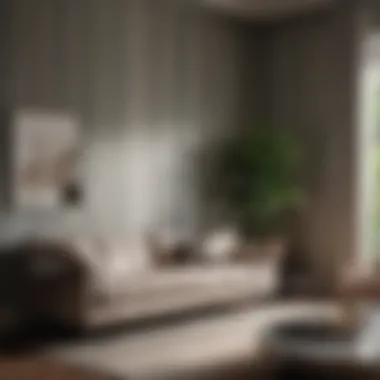

Intro
Wall stripes – a seemingly simple design choice – can dramatically change the atmosphere of a room. They're not just paint on the wall; they are expressions of personality, creativity, and style. As you venture into the world of wall stripe designs, you'll discover how these lines can transform a mundane space into something extraordinary. Whether you're sprucing up a cozy corner or making a bold statement in your living room, understanding the art of stripes is crucial.
This guide will delve deep into wall stripe designs, spotlighting various techniques and layouts that cater to every design aesthetic. From the color palettes that speak to your soul to the nitty-gritty details on maintenance and budgeting, there's something for everyone. Get ready to uncover many practical insights, whether you're a seasoned decorator or a weekend warrior looking for fresh ideas.
Design Inspiration
Trending Styles
In recent times, wall stripe designs have seen a renaissance. Homeowners are moving away from plain, monotonous walls and opting for bold stripes that command attention. Among the trending styles, we see:
- Horizontal Stripes: These stripes create an illusion of wider spaces and work wonders in small rooms. A soft, pastel hue can make a room feel open and airy, while darker colors offer elegance.
- Vertical Stripes: Ideal for ceilings that seem too low, vertical stripes draw the eye upward, creating an impression of height. Experimenting with varied widths enhances visual interest.
- Diagonal Stripes: For those who dare to be different, diagonal stripes add a dynamic vibe. They can break the rigidity of straight lines and inject energy into a room.
- Color-block Stripes: Mixing bold colors with solid blocks can create a striking feature wall. Think of it as having two designs in one.
Color Palettes
When choosing colors, it is no longer about sticking to conventional shades. Wall stripes can showcase a vibrant array, ensuring the completed look complements your existing decor.
- Monochromatic Schemes: Using varying shades of a single color can provide depth without overwhelming a space. This subtle approach adds sophistication.
- Contrasting Colors: Pairing complementary colors, such as navy and mustard or teal and coral, creates a bold, eye-catching statement. It can invigorate the room in a manner that's fresh yet beautifully cohesive.
- Soft and Neutral Hues: For those who prefer a subtle touch, soft pastels like mint green or blush pink can create a tranquil atmosphere. They can also act as a backdrop for bolder accents.
"Color is the keyboard, the eyes are the harmonies, the soul is the piano with many strings." - Wassily Kandinsky
Practical Tips
Maintenance & Care
Once you transform your walls with stripes, maintaining their pristine appearance becomes paramount. Simple tips include:
- Use a damp cloth for routine cleaning to avoid damage to the paint.
- Paint touch-ups may be needed over time, especially in high-traffic areas. Keep leftover paint handy.
- Consider satin or semi-gloss paint for stripes, as these finishes resist stains and are easier to clean.
Budgeting & Planning
A successful wall stripe project doesn't necessarily have to break the bank. Here’s how to make it budget-friendly:
- Do-It-Yourself: Rather than hiring professionals, many homeowners opt for DIY for both financial savings and personal satisfaction. A few resources are available online to guide you through the process.
- Sample Paints: Buy sample pots to test colors on your walls before committing. It might save you from costly mistakes later on.
- Plan Ahead: Measure your wall space to ensure you buy the right amount of paint. Planning prevents wasted materials and funds.
In wrapping up this introduction to wall stripe designs, it’s clear that stripes offer diverse opportunities for creative expression. Each stripe tells a story that aligns with your style and vision, contributing to a beautifully decorated space.
Prelims to Wall Stripe Designs
Wall stripe designs can shift the atmosphere in any space, effortlessly leading to a jaw-dropping transformation. More than simple aesthetic choices, they weave together color, pattern, and texture to forge unique environments. These stripes can enhance rooms, create illusions of spaciousness, or even emphasize architectural features.
The psychological impact of stripes cannot be understated. For example, vertical stripes can inspire feelings of height and elegance, making a smaller room feel grander. Horizontal stripes, on the other hand, often convey stability and warmth, naturally guiding a person’s gaze across the room. Understanding these nuances is essential for anyone looking to enhance their environment.
When one delves into wall stripe designs, it unravels a whole world of creativity. Not only do stripes provide visual interest, but they also allow homeowners to express their personal style. Whether it’s sophisticated monochromes in a loft or vibrant colors in a child’s playroom, the possibilities are nearly endless.
Moreover, there are technical considerations to keep in mind. Achieving clean lines and cohesive color blends can be challenging but rewarding. Taking time to plan layout strategies, as well as selecting appropriate colors, will ensure that the end result aligns with your vision and objectives.
"Stripe designs represent the intersection of function and aesthetics, as they can affect both perception and mood in living spaces."
Ultimately, wall stripe designs serve as more than mere decoration; they encapsulate the dialogue between creativity and personal expression. By embracing their transformative potential, homeowners and design enthusiasts can breathe new life into any room, making it noteworthy and inviting.
Historical Context of Stripes in Design
Understanding the history of stripes in design sheds light on their longstanding appeal and versatility in interior aesthetics. From ancient civilizations to modern interiors, stripes have served as a visual language, reflecting cultural shifts, technological advancements, and evolving tastes. This history provides context for the modern applications and innovation in stripe design today.
Origins of Stripe Patterns
The origins of stripe patterns can be traced back to various early civilizations. Archaeological findings reveal that cultures such as the Egyptians and the Romans employed stripes in their architectural designs and textiles. These early uses were often symbolic, representing status and power. For example, in ancient Rome, the toga was often striped to denote a senator's rank.
As time went by, stripes found a place in different art forms and fashions. In Europe, during the Middle Ages, striped patterns became popular among the nobility in tapestries and attire, often indicating wealth and sophistication. The visual impact of stripes didn’t just stop at mere decoration; they carried significant meanings. They represented the duality of order and chaos, linked to their mathematical properties.
Evolution Over the Decades
Stripes have undergone significant evolution over various decades, adapting to the changing cultural, social, and economic landscapes. In the early 20th century, stripes became prominent in modern design as movements like Art Deco embraced bold patterns and geometric shapes. The advent of new printing technologies also marked a turning point, making it easier to produce striped textiles and wallpapers.
By the mid-20th century, with the rise of abstract art and design, stripes began to morph into more experimental forms. They were used as a way to create illusions of depth and movement within spaces. The influence of designers like Piet Mondrian, who famously utilized stripes in his artwork, sparked a wave of inspiration for wall designs that continue to resonate today.
In later years, stripes earned a different status, becoming a staple in home decor and even commercial spaces. Their versatility allowed designers to use stripes to evoke different atmospheres—from calming beach-house stripes to vibrant, energizing patterns in kids' rooms. The blending of cultural styles also led to new interpretations of stripes, incorporating elements from global patterns that became trending in the 21st century.
"Stripes, in their simplicity, carry the weight of history, evolving across time to become an emblem of both tradition and innovation."
The historical context of stripes in design not only emphasizes their aesthetic significance but also underscores their functional versatility. Each stripe, whether vertical, horizontal, or diagonal, is a part of a rich narrative that shapes our spaces today. As we navigate modern interior design, recognizing this context can elevate the choices homeowners and decorators make in their wall stripe applications.
Types of Wall Stripe Designs
When it comes to interior design, wall stripes are a powerful tool that can transform an ordinary space into something special. Understanding the various types of wall stripe designs is crucial for any homeowner or design enthusiast looking to enhance their interiors. Each stripe style offers unique visual dynamics, creating different moods, bringing depth, or drawing attention to specific areas within a room.
Vertical Stripes
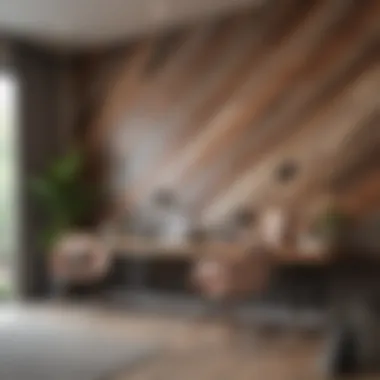
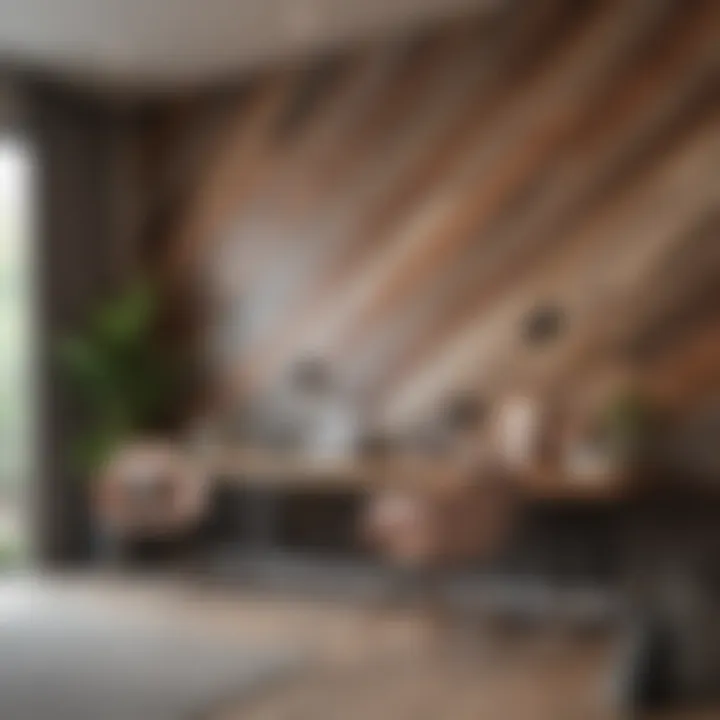
Vertical stripes are a classic choice, often used to create an illusion of height in a room. This style is particularly effective in spaces with low ceilings, as these stripes can lead the eye upward, making the space feel more expansive. Additionally, vertical stripes often evoke a sense of elegance and sophistication, aligning well with both contemporary and traditional decor.
The impact of color in vertical stripes cannot be understated. Light, airy colors can enhance the feeling of verticality, while darker shades can bring a more dramatic flair. Consider using shades that complement the existing color palette of the room; for example, a deep navy can ground a space that features lighter furniture.
"Vertical lines can stretch the room out, giving a fresh breath to compact spaces."
Horizontal Stripes
Horizontal stripes, on the other hand, can add a sense of stability and warmth to a room. They are ideal for making a narrow space feel wider, creating an inviting atmosphere. This design is great for spaces like hallways or narrow living rooms, where the aim is to open up the area.
Moreover, the thickness of the stripes can further influence the feel of the space. Wider stripes can make a bold statement, while thinner stripes offer a more subtle touch. A recurring idea is to balance these with solid blocks of color to avoid visual chaos. Harmonious color combinations, such as soft gray and off-white, may bring a sense of tranquility to a home.
Diagonal Stripes
Diagonal stripes bring an element of dynamism and movement into a room. They can be an exciting choice for creative spaces like art studios or children's rooms, giving off an energetic vibe. The angles can create an illusion of depth and can draw attention to certain areas of the wall, such as an accent wall behind a piece of furniture.
In terms of application, these stripes can be more challenging to paint or apply, due to the need for precise measurements and alignment. However, the end result can produce stunning visual effects that more traditional stripe designs cannot achieve. Mixing diagonal stripes with complementary shapes or colors can create an overall energetic design that invigorates any space.
Textured Stripes
Textured stripes take wall design to a new level, introducing tactile elements to the visual aesthetic. These can include raised paint techniques, fabric wallpaper, or even wood paneling painted in striped designs. The added dimension can create shadows and highlights, making walls appear alive and changing with the light throughout the day.
Textured stripes not only catch the eye but can also add warmth and coziness to a room, making them perfect for more intimate settings. When selecting materials, consider how they will interact with light and other surfaces in the room. For instance, a matte finish can soften a look, while glossy finishes can add a chic edge.
Incorporating different types of wall stripe designs offers numerous benefits, each contributing to the character of the space. As you explore wall stripe designs, think about how these designs can work together or stand alone to create memorable environments.
Techniques for Creating Wall Stripes
Creating wall stripes is more than just a decorative choice; it's about transforming space in a way that's compelling and personal. It can add dimension and intrigue, providing visual interest while also reflecting the personality of the occupant. The techniques discussed here are crucial because they equip homeowners and interior enthusiasts with the skills to tailor their environments to their tastes.
No two rooms need to look alike when stripes can be applied with so many different methods. A few factors come into play when choosing a technique, such as the surface texture, desired permanence, and the overall aesthetic goals of the room. Let's dive into three well-established methods for creating wall stripes: painting methods, using wallpaper, and applying vinyl decals.
Painting Methods
Painting is the most traditional and widely used technique for creating wall stripes. It allows for extensive customization in terms of color, width, and pattern layout.
When opting for painting, here are some key aspects to consider:
- Preparation: The wall surface needs to be clean and smooth. Any existing imperfections might cast shadows and defeat the purpose of a sleek stripe.
- Measuring and Marking: Use a measuring tape to determine where the stripes will go. Chalk lines or painter's tape can aid in achieving straight lines, which is crucial in maintaining a clean look.
- Color Choices: Choosing contrasting colors can create bold stripes, while similar shades can yield a more subtle look. The decision should align with the ambiance you wish to curate in the space.
"A thoughtfully painted stripe can single-handedly uplift the energy of a room."
Using Wallpaper
Wallpaper offers another creative avenue for stripe designs. Many wallpaper options come pre-striped or in patterns that can be combined for a striped effect.
Benefits of using wallpaper include:
- Ease of Installation: For those who prefer a quick fix, some wallpaper types can be easily peel-and-stick. This means less mess compared to paint.
- Variety of Styles: From vinyls featuring photographs to textured papers, wallpaper allows for both subtle and striking effects that paint alone can't achieve.
- Durability: Depending on the type of wallpaper used, it can stand up to wear and tear—an appealing option for spaces like children's rooms or high-traffic areas.
Applying Vinyl Decals
Vinyl decals have gained popularity due to their versatility and ease of use. They can be applied quickly and removed without causing damage to walls, making them especially suitable for renters.
Here are some insights on using vinyl decals:
- Customizable Designs: Many companies offer bespoke designs, which let you get exactly the stripe look you envision.
- Less Time-Consuming: Compared to other methods, applying decals can be done in a fraction of the time. Simply clean the wall, align the decals, and press them into place.
- Temporary Solutions: Vinyl decals cater well to trends, allowing you to swap out designs as your style evolves.
With these three primary techniques, creating wall stripes can be a fulfilling venture that enhances not only the aesthetic of a space but also the occupant's daily experience. Each method carries unique advantages, and taking the time to consider your project's needs can result in stunning transformations.
Color Choices in Stripe Design
Color choices stand as a cornerstone in the design of wall stripes. They not only define the overall aesthetic of a space but also evoke emotions and influence behavior. When one imagines stripes on a wall, it's not merely about the alignment of colors; it's about how those colors interact and create an atmosphere in the environment. In essence, selecting the right colors can elevate a straightforward stripe design into something truly transformative, embracing both personality and purpose.
The nuances of color impact everything from the mood of a room to the perception of space. For instance, a soft blue stripe can make a narrow hallway feel more expansive, while vibrant yellows can inject energy into a stagnant living room. The numerous benefits of strategically chosen colors encourage homeowners and designers alike to consider the psychological implications tied to hues.
Furthermore, color choices can reflect personal style and the functional requirements of designated spaces. A playful pattern appropriate for a child’s room might not translate well into a formal office environment. Thus, being mindful of color contexts is vital.
Impact of Color Psychology
Color psychology delves into how colors affect human emotions and perceptions. Different shades evoke various feelings:
- Blue tends to bring calmness and serenity, making it ideal for bedrooms or quiet spaces.
- Red, on the other hand, is often associated with energy and passion, perfect for spaces designed for interaction, such as dining areas.
- Green symbolizes nature and tranquility, which makes it a great choice for creating a refreshing ambiance.
Understanding these psychological effects helps in choosing colors that not only suit the aesthetic goals but also cater to desired emotional impacts.
"Not every color serves the same purpose; thoughtfully choosing them aligns with the sought-after feelings one wishes to experience in the space."
It's interesting to note that lighter colors can make a room feel more expansive, while darker shades can create an intimate, cozy setting. In addition to emotions, colors have cultural implications. For instance, in some cultures, white represents purity and cleanliness, while in other cultures, it's associated with mourning.
Popular Color Combinations
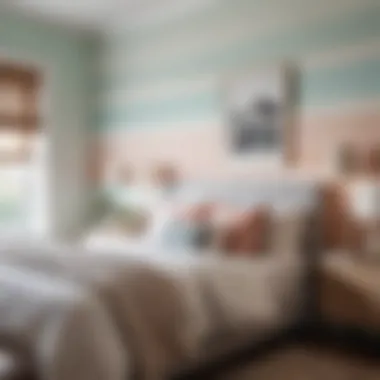

When it comes to wall stripe designs, combining colors can lead to striking visual effects. Here are a few popular combinations:
- Navy Blue and White: This classic pairing brings a nautical vibe, especially effective in bathrooms or coastal homes.
- Grey and Blush Pink: A modern combo that conveys sophistication, suitable for bedrooms or studios.
- Black and Gold: For those looking to create a sense of luxury and drama, this combination stands out.
- Teal and Coral: These colors work well together, producing a fresh yet lively appearance, particularly great for living rooms.
These combinations aren’t just visually appealing; they also help create a harmonious feel in the space. When planning your stripe designs, consider the ambiance you want to convey and how colors can escalate that experience. As you experiment with these combinations, remember to lean into personal preferences and the mood you seek.
Layout Strategies for Wall Stripes
The arrangement of wall stripes plays a crucial role in interior design, determining not just the aesthetics but also influencing the broader atmosphere of a space. Effective layout strategies can help create a cohesive look that fosters comfort and elegance. Considerations such as the proportion of the space, the desired focal points, and the interaction of colors all contribute significantly to the successful implementation of wall stripe designs. Stripes can visually elongate or widen a room, and understanding how to utilize this potential can make all the difference in your decorating journey.
Creating Focal Points
When we talk about focal points, it’s about grabbing attention in a way that's both subtle and striking. Wall stripes can be used to guide the eye towards specific features within a room. For instance, a bold, thick stripe pattern can act as a visual anchor behind a piece of furniture or art, making it the center of attention.
- Horizontal stripes might make a low ceiling feel higher, while vertical stripes can draw the gaze up to an architectural element.
- In a child’s room, playful patterns can become a backdrop for a bed or play area, creating a space that feels energetic yet organized.
The key is ensuring that the focal point is complemented, not overwhelmed, by the stripes. Choose a wall strategically to highlight a feature, such as a fireplace, a large window, or an architectural detail. Remember, less is often more when creating visual appeal.
Balancing Patterns and Solids
Patterns can be exciting, but if overused, they can turn a beautiful room into a chaotic mess. Here’s where the balance comes in. It's important to mix stripes with solid colors carefully to maintain visual harmony. A good way to do this is to alternate between striped walls and solid accents.
- Use stripes on one wall, while keeping the adjacent walls in a solid, complementary color.
- This can frame the striped wall, allowing for the eye to flow through the space rather than be jostled by overwhelming patterns.
Pay attention to the scale of the stripes in relation to the other elements in the room. A room filled with large furniture pieces may benefit from bolder, wider stripes, whereas a space with petite furnishings might be better suited for narrower stripes to maintain a sense of balance.
Incorporating Other Design Elements
Wall stripes don’t have to stand alone. They work best when woven into the broader fabric of the room’s design. Consider how other elements interact with your stripe design.
- Textures: Combine stripes with textured finishes, such as wallpapers with a slight sheen or fabric wall coverings, to add depth to the stripes.
- Furniture: Incorporate furnishings with complementary colors or patterns; for example, a muted sofa can balance vibrant stripes well.
Moreover, accessories like artwork, rugs, or curtains can enhance the overall theme you're building. It's often beneficial to pull colors from the wall stripes into other elements. This creates a cohesive flow, unifying the space as one harmonious entity.
By deliberately planning your layout, you can turn a simple stripe design into a stunning visual statement.
The strategic placement of wall stripes in consideration of focal points, balanced patterns, and design elements is essential. These strategies empower homeowners and design enthusiasts alike to maximize the transformative potential of wall stripes in their interiors.
Practical Application of Wall Stripes
Utilizing wall stripes in interior design has become increasingly relevant as individuals seek to infuse their spaces with personality and style. Wall stripes are not just an aesthetic choice; rather, they play a pivotal role in the overall ambiance and functionality of a room. They can create an illusion of height or width, guide the eye, and even influence mood. When applied thoughtfully, wall stripes can elevate an otherwise mundane space into something that feels alive and well-curated.
In Living Spaces
When it comes to living areas, wall stripes can serve multiple purposes. Consider the balance of colors and patterns; for example, a soft palette in vertical stripes can create an impression of elevation, making the room feel more spacious. Alternately, horizontal stripes can visually extend the length of the room, giving it a warmth that invites relaxation.
Incorporating wall stripes in living spaces should involve careful planning. Think about:
- Color Consistency: Ensure color choices resonate with existing decor.
- Stripe Width: Thinner stripes tend to create a more delicate, serene feel, while thicker stripes provide a bold statement.
- Texture Effects: Using textured materials like wallpaper with stripes can add depth and richness.
Ultimately, these strategies can transform a space from to , enhancing its versatility for both lounging and entertaining.
In Kids' Rooms
Kids' rooms are a playground for creativity where the sky's the limit. Stripes can add a spirited energy to a child's environment, promoting playfulness while also serving educational purposes. For instance, using cheerful colors in stripes not only makes the room more inviting but can also aid in color recognition.
A few considerations for stripes in kids' rooms:
- Selecting Playful Colors: Bright hues can inspire joy, while softer tones can create a calm retreat.
- Durable Materials: Children can be tough on their spaces, so opting for washable paint or resilient wallpaper is prudent.
- Unique Patterns: Combining stripes with other patterns, like polka dots or stars, can create a fun, whimsical atmosphere.
Incorporating wall stripes can also evolve as children grow, allowing for easy updates to maintain a stylish environment that fits their changing interests.
In Commercial Spaces
In commercial settings, wall stripes can convey brand identity and enhance customer experience. Stripes can be employed to guide customer movement, break the monotony of office walls, and create inviting atmospheres. For retail locations, a carefully curated stripe design can draw attention to specific areas, such as promotions or new products.
Some key aspects of implementing stripes in commercial spaces include:
- Professional Appearance: Choose more subdued colors and refined designs to reflect the company’s brand ethos.
- Strategic Placement: Use stripes to lead customers' eyes to products, showcasing key items or areas effectively.
- Adaptability: The easy application of wall stripes allows businesses to refresh their look without significant renovations.
Challenges and Solutions in Stripe Design
The world of wall stripe designs can be fascinating yet challenging. As homeowners and design enthusiasts explore ways to enhance their spaces, they often encounter hurdles that require thoughtful solutions. A well-planned stripe design can add depth and character to a room, but uneven walls and small spaces pose specific issues that can deter effective implementation. Understanding these challenges and how to navigate them is crucial for achieving desired aesthetic outcomes. By addressing these common design concerns, one can optimize the use of wall stripes, ensuring they enhance rather than detract from a room's overall look.
Dealing with Uneven Walls
Uneven walls can throw a real wrench into the plans for a striking stripe design. You might visualize bold lines, but as soon as the tape goes up, all those little imperfections start to show. The truth of the matter is that many homes, especially older ones, have walls that aren’t completely level. Instead of allowing these flaws to dictate the design, there are various strategies to work around them.
- Use Textured Stripes: One approach is to embrace the imperfections. Textured stripes can work wonders in camouflaging bumps and dips. Instead of straight lines, think about using a series of wavy or rugged patterns that draw the eye without emphasizing wall flaws.
- Avoid Tape: While tape is a go-to for many, it may not be suitable for uneven surfaces. You might consider freehand painting or using a painted stencil pattern instead. This allows for a more organic look that doesn't depend as heavily on precise lines.
- Consider Vertical Stripes: Vertical wall stripes often create the illusion of added height. If the walls aren’t perfectly straight, this can help divert attention away from uneven areas, making the room feel taller and more spacious.
- Install Wood or Fabric Panels: If the unevenness is severe, think about installing wood or fabric panels on the wall. Not only can this smooth out the surface, but it introduces an inviting texture that can complement stripe designs beautifully.
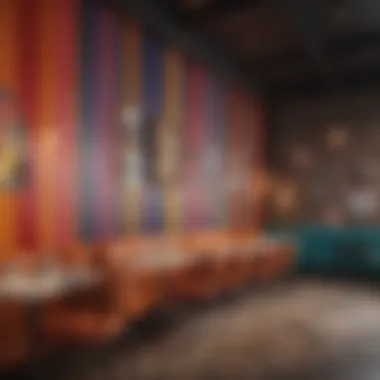
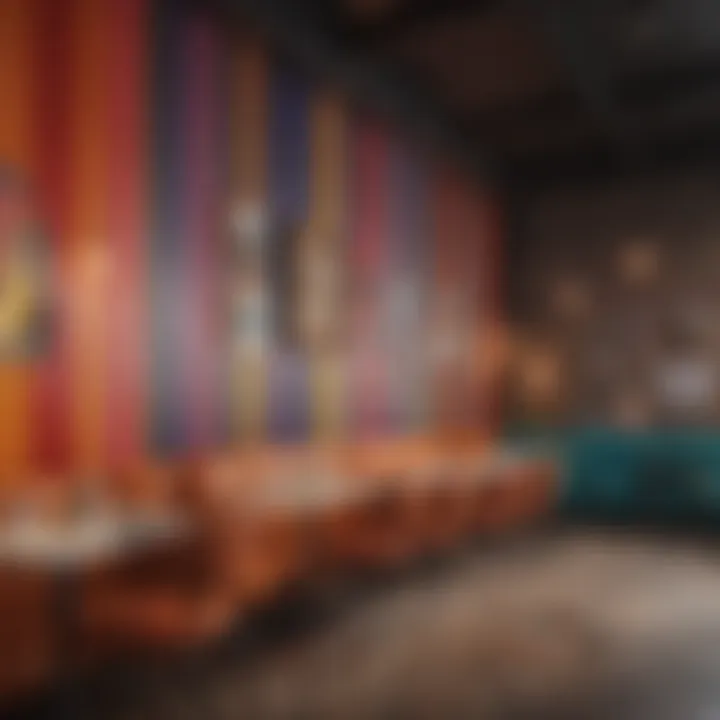
"Creating visually appealing spaces often means being creative in overcoming structural challenges. Embrace imperfections as character."
Avoiding Overwhelm in Small Spaces
Small spaces often demand a delicate touch when it comes to bold designs, such as wall stripes. While stripes can expand the feel of a room, missteps can easily lead to overwhelming the space. Striking a balance is key.
- Choose Lighter Colors: Opt for lighter or pastel colors when creating stripes in cramped quarters. These shades can open up the room, making it appear larger and airier. Avoid dark colors, as they tend to absorb light, which can make a small space feel even tighter.
- Limit Stripe Width: Instead of broad stripes, go for thinner ones. Narrow stripes can add visual interest without overpowering a small area. They can also create a subtle texture that adds depth without taking over the entire wall.
- Use Horizontal Stripes Wisely: Horizontal stripes can make a room feel wider. However, they can also draw attention to a low ceiling. If the ceiling is notably low, it might be better to avoid this approach and stick with vertical or subtle diagonal stripes.
- Incorporate Negative Space: Leaving some parts of the wall unpainted or using solid colors alongside stripes helps create breathing room in a compact area. This negative space can allow the eye to rest, preventing visual clutter.
By being aware of the unique challenges posed by uneven walls and small spaces, homeowners and design enthusiasts can explore creative solutions that ensure wall stripe designs contribute positively to their environments. Incorporating these considerations allows for a thoughtful approach, turning potential weaknesses into strengths.
Evaluating the Impact of Wall Stripes
Wall stripes are more than just mere adornments; they embody a dynamic element in interior design that deserves thorough evaluation. Understanding their impact is critical for designers and homeowners who are looking to reshape spaces with both style and purpose. This section delves into how wall stripes can transform a room, touching on aesthetic values and functional aspects that might not be immediately apparent.
Aesthetic Value
When it comes to aesthetics, wall stripes possess a unique flair. They can serve as bold statements or subtle enhancements, depending on how they're applied. Consider, for instance, how vertical stripes can create an illusion of height in a room with low ceilings. By drawing the eye upwards, they can almost trick the brain into perceiving a more spacious environment. Horizontal stripes, on the other hand, can stretch a room visually, giving it a more expansive feel.
Color plays a pivotal role here; vibrant shades can energize a space, while softer tones may evoke tranquility. Stripes can also be utilized to guide the focus of attention towards particular areas, like artwork or furniture arrangements. For example, painting a feature wall with alternating bold and muted stripes can create a stunning backdrop for a gallery wall.
"Design is not just what it looks like and feels like. Design is how it works."
— Steve Jobs
In addition to size perception, stripes can weave a story throughout the home. Each room can have its own rhythm and character punctuated by stripes. Furthermore, when paired with various textures, such as a velvety finish or a matte effect, they can elevate a room's sophistication and create a unique visual language that resonates with personal style.
Functional Aspects
Wall stripes aren't solely for decoration; they harness functional benefits that can affect how a space is experienced. For instance, in highly trafficked areas of a home, like a hallway or entryway, stripes can serve as a practical solution for hiding scuff marks and dirt. Darker colors or intricate patterns can camouflage these imperfections effectively, reducing the need for frequent touch-ups and upkeep.
In commercial spaces, stripes can guide behavior and even regulate mood. A well-placed stripe pattern in a restaurant can encourage flow and movement, while stripes in an office can enhance productivity by breaking the monotony of blank walls.
Additionally, stripes can be instrumental in defining zones in open floor plans. For instance, utilizing stripes to delineate a dining area from a living space can subtly signify functionality without the need for physical barriers. In children's rooms, playful stripes can stimulate creativity and bring a sense of fun, marking that space as a safe haven for play and imagination.
In essence, evaluating the impact of wall stripes is a robust exercise in understanding both their beauty and utility. Stripes not only serve to beautify environments but are also essential tools in creating functional living and working spaces. As we move forward in this exploration of wall stripe designs, it’s crucial to appreciate these dualities.
Cultural Influences on Stripe Design
In today's world of interior design, understanding cultural influences on stripe patterns is essential. Stripes are not just a simple decoration; they carry historical significance and social messages that resonate across diverse societies. Much like the colors a designer picks, the stripe pattern's origin can infuse a room with meaning and character, making it vital for design enthusiasts to recognize these elements. By examining how different cultures incorporate stripes, one gets a clearer picture of their place in modern aesthetics.
Global Patterns and Styles
Stripes have found their way into the design aspects of many cultures, with each bringing something unique to the table.
- Japanese Tatami Stripes: In Japan, tatami mats, often found in traditional homes, incorporate subtle stripe patterns woven into the fabric. These textures evoke a sense of serenity and are deeply tied to the cultural appreciation for nature and minimalism.
- African Mudcloth: Patterns in African mudcloth often feature stripes that hold symbolic meanings, representing social status or ancestral stories. This provides colorful yet significant backgrounds when applied to walls.
- Nautical Stripes in Mediterranean Design: Traditionally, nautical patterns with blue and white stripes are prominent in coastal Mediterranean cultures. They provide a fresh and breezy vibe, reflecting the proximity to water and the overall lifestyle.
Incorporating these elements can act as an homage to their origins while making a bold statement in homes. Using designs inspired by these cultural stripes can lead to a conversation starter, creating intriguing layers that explain stories from different parts of the world.
Modern Interpretations
With globalization, the interpretation of stripes has evolved significantly. Different cultures continue to reinvent stripes, adjusting them to fit modern aesthetics while respecting their origins. Contemporary designers have begun to blend traditional patterns with minimalistic designs, creating a new dialogue in stripe aesthetics.
- Geometric Variations: Today, many designers are moving towards geometric interpretations of stripes, using unexpected color combinations and shapes that surprise the viewer. This blend maintains the essence of stripes while infusing a modern twist.
- Sustainable Textiles: Modern interpretations are also seen in eco-friendly textile designs. Stripes made from recycled materials are not just visually appealing but tell a story of conscious consumption, merging style and sustainability.
- Digital Adaptations: The rise of digital design platforms has allowed for fluidity in stripe designs that were previously constrained by traditional mediums. Designers can now experiment and play with colors and shapes as never before.
Exploring stripes through the lens of cultural influences can illuminate the narratives behind designs and inspire thoughtful choices in home decor. Understanding these nuances can lead to more meaningful interior spaces as they reflect a blend of history and personal expression.
The Future of Wall Stripe Designs
As design landscapes evolve continuously, understanding the future of wall stripe designs stands as a significant focus for many homeowners and decor enthusiasts. This section not only highlights emerging trends but also embraces the potential applications of advanced technology, thus redefining how stripes influence a given space. Nailing down what the next iteration of wall stripes might look like can inspire fresh takes on existing designs and encourage innovative creations that reflect individual personalities and aesthetics.
Emerging Trends
Anticipating where wall stripe designs are headed requires us to observe current movements and adapt their lessons. Here are a few trends gaining traction:
- Sustainable Materials: As eco-consciousness rises among consumers, there's a push towards using sustainable and recyclable materials in stripe design. Whether it's paint derived from natural sources or wallpapers made from recycled fibers, this trend is both good for the environment and appealing to a growing demographic that values sustainability.
- Mixed Applications: Blurring the lines between painting, wallpaper, and decals is becoming more commonplace. What if you could combine vinyl with painted stripes? The ability to create customized combinations can lead to unique expressions that are rich in character and depth.
- Geometric and Abstract Patterns: While classic stripes have their charm, geometric designs are stepping into the spotlight. From zigzags to wave-like patterns, step it up by mixing in bold colors or using gradients to make spaces pop. The idea is to create a dynamic look that catches the eye without overwhelming the senses.
"Living spaces should be a reflection of oneself—embracing these subtle complexities can serve that purpose."
- Personalization: Getting creative with wall stripes means tapping into personal stories or memories. Some people might choose colors that remind them of a favorite place, or patterns that represent cherished family traditions. Tailoring designs to individual experiences is an emerging trend above all.
Technological Innovations
Delving into technological advancements can also shed light on the future of wall stripe designs. Below are a couple of noteworthy options that homeowners or decorators might want to keep an eye out for:
- Augmented Reality (AR): This tech is not just for gaming anymore. Imagine being able to visualize how various stripe patterns and colors would look in your space through AR apps before committing to the final design. By using smartphones or tablets, potential risks can be reduced, enabling decisions that feel right at home.
- Smart Paint Technology: Innovations are leading to paints that can change color based on temperature or light conditions. This technology could allow spaces to reflect different moods throughout the day, utilizing wall stripes that adapt to their environments.
- 3D Wall Systems: Some producers are exploring 3D-printed wall structures that create dimension through stripes, enhancing visual interest while providing the illusion of depth. This can bring a new dimension to interiors, setting apart traditional flat designs.
- Digital Printing: The ability to digitally print custom stripe designs opens up a world of options. Homeowners can collaborate with designers to produce one-of-a-kind patterns, thus transforming their spaces into canvases of personal art.
Epilogue
Drawing from the insights explored throughout this article, the conclusion serves not just as a closing remark but as an essential summation of the significance that wall stripe designs hold in interior decoration. The layers of complexity and creativity involved in stripe design exemplify how a simple idea can morph into a powerful tool for aesthetic transformation in any space.
Key Takeaways:
- Versatility: Wall stripes contribute to a room's character without overwhelming it. They can range from subtle, textured lines to bold, eye-catching patterns, allowing homeowners to adapt their designs based on personal taste and the unique ambiance they desire.
- Enhancing Spatial Perception: A well-placed stripe can manipulate the perception of space—whether it’s making a ceiling feel higher or a room appear wider. This gives users a strong incentive to consider how wall stripes can enhance functionality along with beauty.
- The Power of Color: The interplay of colors within stripe designs is crucial. The emotional responses linked to different shades can set the tone of a room and affect its overall vibe. Homeowners can curate experiences for themselves and guests purely through color choices paired with stripe patterns.
Moreover, as we focus on the aesthetics, it’s essential not to neglect the practicalities. The techniques discussed previously—be it painting over existing walls, utilizing wallpaper, or applying vinyl decals—all highlight how accessible striped designs can be for anyone daring enough to embark on a decorating journey.
Additionally, considering the cultural influences on stripe design not only broadens the scope of inspiration but also fosters a connection to diverse artistic expressions and styles from around the globe. This diverse dialect of design can turn a plain wall into a conversation starter.
To wrap it all up, embracing wall stripe designs opens doors to endless possibilities in interior decoration. Homeowners, interior design enthusiasts, and even the occasional party host can utilize stripes not just as a decorative element but as a means of self-expression. It elevates rooms, narrates stories, and imbues life into spaces. Whether one opts for majestic verticals or whimsical diagonals, the art of stripes is truly a transformative endeavor.















